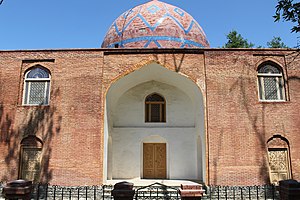Shaykh Junayd

| Part of a series on Shia Islam |
| Twelver Shi'ism |
|---|
|
|
Sheikh Junayd (died 1460) (Persian: شیخ جنید Shaikh Junaid) was the son of Shaykh Ibrahim, father of Shaykh Haydar and grandfather of the founder of Safavid dynasty, Shah Ismail I. After the death of his father, he assumed the leadership of the Safaviyya from 1447–1460.
History
[edit]Under Junayd, the Safaviyya was transformed from a Sufi order organized around a saint-ascetic into an active military movement with a policy of conquest and domination. He was the first Safavi spiritual leader to espouse specifically Shia Islamic teachings, and in particular those of the Twelver ghulat.[1][2] Junayd was viewed as a divine incarnation by his followers.[3][4]
During his time in Ardabil, Junayd attracted so many disciples that in 1448, Jahan Shah (the Kara Koyunlu prince) drove him into exile to Anatolia and Syria. While there, he engaged in missionary activities and accumulated Turkmen followers.[5] He then went to the court of Uzun Hassan at Diyarbakır, where he married Uzun Hassan's sister, Khadija Khatun, somewhere between 1456 and 1459.[6]
Junayd was prevented from returning to Ardabil, so he lived at Shirvan where he died in a local skirmish near the Samur River in what is modern Azerbaijan, where he was buried. This led to the beginning of animosity between the mainly Sunni Shirvanshah and the increasingly heterodox Shi’i Safaviyya.[7]
Mausoleum of Sheikh Juneyd is located in the village of Khazra in Azerbaijan. Junayd was succeeded by his son Shaykh Haydar, who married his cousin Halima Alamshah Khatun, daughter of Uzun Hassan and Theodora Despina Khatun. They had three sons and three daughters. One of them was Shah Ismail I, father of Shah Tahmasp I.
Succession
[edit]See also
[edit]Notes
[edit]- ^ Vincent J. Cornell,Voices of Islam: Voices of tradition, pg.225
- ^ Seyyed Hossein Nasr,Traditional Islam in the modern world, pg.61
- ^ Jaroslav Krejčí, Anna Krejčová, Before the European challenge, pg.151
- ^ Farhad Daftary. The Ismāʻı̄lı̄s, pg.466
- ^ Kathryn Babayan, Mystics, monarchs, and messiahs, pg.139
- ^ Andrew J. Newman, Safavid Iran, pg.129
- ^ Percy Molesworth Sykes, A History of Persia, pg.240-241
External links
[edit]- JONAYD Encyclopædia Iranica
Text is available under the CC BY-SA 4.0 license; additional terms may apply.
Images, videos and audio are available under their respective licenses.
